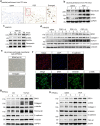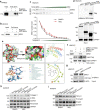Brahma-related gene 1 acts as a profibrotic mediator and targeting it by micheliolide ameliorates peritoneal fibrosis
- PMID: 37726857
- PMCID: PMC10510267
- DOI: 10.1186/s12967-023-04469-w
Brahma-related gene 1 acts as a profibrotic mediator and targeting it by micheliolide ameliorates peritoneal fibrosis
Abstract
Background: Progressive peritoneal fibrosis is a worldwide public health concern impacting patients undergoing peritoneal dialysis (PD), yet there is no effective treatment. Our previous study revealed that a novel compound, micheliolide (MCL) inhibited peritoneal fibrosis in mice. However, its mechanism remains unclear. Brahma-related gene 1 (BRG1) is a key contributor to organ fibrosis, but its potential function in PD-related peritoneal fibrosis and the relationship between MCL and BRG1 remain unknown.
Methods: The effects of MCL on BRG1-induced fibrotic responses and TGF-β1-Smads pathway were examined in a mouse PD model and in vitro peritoneal mesothelial cells. To investigate the targeting mechanism of MCL on BRG1, coimmunoprecipitation, MCL-biotin pulldown, molecular docking and cellular thermal shift assay were performed.
Results: BRG1 was markedly elevated in a mouse PD model and in peritoneal mesothelial cells cultured in TGF-β1 or PD fluid condition. BRG1 overexpression in vitro augmented fibrotic responses and promoted TGF-β1-increased-phosphorylation of Smad2 and Smad3. Meanwhile, knockdown of BRG1 diminished TGF-β1-induced fibrotic responses and blocked TGF-β1-Smad2/3 pathway. MCL ameliorated BRG1 overexpression-induced peritoneal fibrosis and impeded TGF-β1-Smad2/3 signaling pathway both in a mouse PD model and in vitro. Mechanically, MCL impeded BRG1 from recognizing and attaching to histone H3 lysine 14 acetylation by binding to the asparagine (N1540) of BRG1, in thus restraining fibrotic responses and TGF-β1-Smad2/3 signaling pathway. After the mutation of N1540 to alanine (N1540A), MCL was unable to bind to BRG1 and thus, unsuccessful in suppressing BRG1-induced fibrotic responses and TGF-β1-Smad2/3 signaling pathway.
Conclusion: Our research indicates that BRG1 may be a crucial mediator in peritoneal fibrosis and MCL targeting N1540 residue of BRG1 may be a novel therapeutic strategy to combat PD-related peritoneal fibrosis.
Keywords: BRG1; Micheliolide; Peritoneal dialysis; Peritoneal fibrosis; TGF-β1.
© 2023. BioMed Central Ltd., part of Springer Nature.
Conflict of interest statement
The authors declare no competing interests.
Figures








Similar articles
-
Dimethylaminomicheliolide ameliorates peritoneal fibrosis through the activation of autophagy.J Mol Med (Berl). 2019 May;97(5):659-674. doi: 10.1007/s00109-019-01757-1. Epub 2019 Mar 11. J Mol Med (Berl). 2019. PMID: 30854581
-
Parthenolide, an NF-κB inhibitor, alleviates peritoneal fibrosis by suppressing the TGF-β/Smad pathway.Int Immunopharmacol. 2020 Jan;78:106064. doi: 10.1016/j.intimp.2019.106064. Epub 2019 Dec 12. Int Immunopharmacol. 2020. PMID: 31838448
-
BRG1 accelerates mesothelial cell senescence and peritoneal fibrosis by inhibiting mitophagy through repression of OXR1.Free Radic Biol Med. 2024 Mar;214:54-68. doi: 10.1016/j.freeradbiomed.2024.01.054. Epub 2024 Feb 2. Free Radic Biol Med. 2024. PMID: 38311259
-
Diverse roles of TGF-β/Smads in renal fibrosis and inflammation.Int J Biol Sci. 2011;7(7):1056-67. doi: 10.7150/ijbs.7.1056. Epub 2011 Sep 2. Int J Biol Sci. 2011. PMID: 21927575 Free PMC article. Review.
-
Central role of dysregulation of TGF-β/Smad in CKD progression and potential targets of its treatment.Biomed Pharmacother. 2018 May;101:670-681. doi: 10.1016/j.biopha.2018.02.090. Epub 2018 Mar 22. Biomed Pharmacother. 2018. PMID: 29518614 Review.
Cited by
-
Peritoneal fibrosis: from pathophysiological mechanism to medicine.Front Physiol. 2024 Sep 4;15:1438952. doi: 10.3389/fphys.2024.1438952. eCollection 2024. Front Physiol. 2024. PMID: 39301425 Free PMC article. Review.
-
Integrating single-cell RNA-seq, bulk RNA-seq and network pharmacology reveals protective effect of salidroside in peritoneal dialysis-associated peritoneal fibrosis.Front Pharmacol. 2025 Jun 20;16:1558366. doi: 10.3389/fphar.2025.1558366. eCollection 2025. Front Pharmacol. 2025. PMID: 40620673 Free PMC article.
-
Pharmacological potential of micheliolide: A focus on anti-inflammatory and anticancer activities.Heliyon. 2024 Mar 5;10(6):e27299. doi: 10.1016/j.heliyon.2024.e27299. eCollection 2024 Mar 30. Heliyon. 2024. PMID: 38496875 Free PMC article. Review.
References
Publication types
MeSH terms
Substances
LinkOut - more resources
Full Text Sources
Miscellaneous

